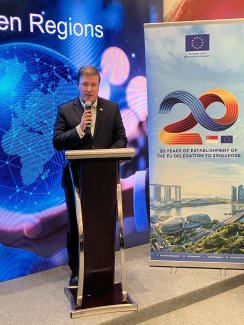Artikkelit

04.06.2025
Singapore attracts and funds foreign researchers strategically to boost innovation and economic growth
Singapore has been very strategic and farsighted in its research and innovation policies. A key success element is to benchmark and attract international top research. There are several funding schemes available for top researchers, who are ready to spend at least part time in Singapore. Connecting with Singaporean research institutions can be very beneficial for Finnish researchers and institutes as well.
Internationalisation is seen as a key success factor
Singapore tends to be very selective and strategic in investing into its research, development and innovation system. An essential element of the RDI policy has long been to foster international interaction to maximize systemic quality. Foreign talents and experts are actively attracted, as they are seen not only as a human resource but also agents of change, who can bring valuable visions and practices from top institutes in other parts of the world.
Thanks to active internationalization policies, Singapore’s top universities have impressive ranking records: National University of Singapore (NUS) is ranked 8th globally and 1st in Asia, and Nanyang Technological University (NTU) is ranked 15th globally and 3rd in Asia (QS World University Rankings 2025). As of the latest available data, Singapore ranks 10th globally in terms of the number of Highly Cited Researchers (HCRs) in 2024, with 108 researchers recognized for their exceptional citation impact. This places Singapore among the top 10 countries worldwide for producing research that ranks in the top 1% by citations within its field and publication year.
Much of this success is based on active recruitment of top-tier researchers from around the world to work at Singaporean institutions. The government has invested heavily in talent attraction through grants, fellowships, and faculty appointments to. The city-state is offering both early-career and senior-level opportunities, often bundled with funding, lab support, and tenure-track roles. As a result, Singapore is one of the most open and well-funded research environments in Asia.
Several funding schemes available
There are several funding schemes for researchers, who are ready to work part time or full time in Singaporean research institutes. National Research Foundation (NRF) offers NRF Fellowships, which target early-career international researchers with strong research potential. A fellowship may provide up to S$3 million over five years, plus a tenure-track faculty position at a Singapore university or research institute. Fellowships are open to all nationalities, and the fellows must be based in Singapore. NRF Investigatorship is for established researchers internationally, offering generous funding (up to S$5 million) to lead high-impact research in Singapore. This measure includes support for setting up labs and research teams in Singapore.
Agency for Science, Technology and Research (A*STAR) actively recruits foreign scientists to work in its institutes or partner universities. A*STAR offers competitive compensation, research funding, and lab facilities. A*STAR also offers Joint Appointments and Visiting Professorships, where foreign researchers may collaborate or take part-time roles in Singaporean institutes.
While not exclusively aimed at foreigners, Singapore’s universities (e.g., NUS, NTU, SUTD) use MOE funding to recruit international faculty and researchers, often bundled with startup packages and lab support. Through initiatives like CREATE (Campus for Research Excellence and Technological Enterprise), Singapore co-funds research centers established by top global universities (e.g., MIT, Berkeley, ETH Zurich), allowing them to bring foreign researchers into Singapore-based projects.
Funding outside Singapore
In general, Singaporean research funding agencies such as A*STAR, Ministry of Education (MOE), National Research Foundation, and National Medical Research Council (NMRC) primarily fund research that is conducted within Singapore or is closely tied to Singapore-based institutions.
However, there are exceptions or conditions where research done outside Singapore may be funded. Some grants allow for international collaborations, where part of the research can be conducted overseas — but typically with a Singapore-based Principal Investigator (PI) or institution as the lead. Examples of this are NRF Competitive Research Programme (CRP) and NRF Investigatorship, which may involve overseas collaborators, but the lead PI must be based in Singapore. A*STAR International Partnerships may support joint projects where a portion is conducted abroad, especially when expertise or facilities are not available locally. Programs such as the A*STAR Graduate Academy fund overseas PhD attachments or training, allowing students to do part of their research abroad under Singapore-based scholarships or grants. If a Singaporean institution (e.g., an overseas campus or joint lab) is involved, funding may be possible, especially if the research benefits Singapore’s strategic interests.
Valuable benchmarks and connections for Finland
Singapore has become a significant regional hub for innovation, businesses, services and financing. In order to sustain and strengthen this position, the country has to cultivate skilled workforce and top-notch RDI infrastructure. Therefore, funding schemes require at least partial presence in Singapore, and visiting professors are expected to foster local innovation culture within their host institute. Singaporean funding policy offers interesting opportunities also for Finnish top researchers. Strong ties to Singapore can be seen beneficial in many ways. At the same time Singaporean funding system offers a valuable benchmark on how to construct highly international and competitive research environment with a relatively small community.
Text: Mika Tirronen
Photo Heli Saari: Minister Ville Tavio giving a speech to local investors in Singapore last week during the SEMICON Southeast Asia Conference and Fair.
